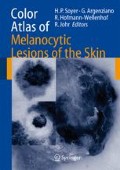Abstract
Although melanocytic nevi are very common, their histogenesis is not well understood. The origin of melanocytic nevi and their natural history is still a matter of debate. According to Unna’s “Abtropfung” theory, melanocytic nevi start in the epidermis and drop off into the dermis [1]. In contrast to the theory of “Abtropfung,” the theory of “Hochsteigerung” suggests that melanocytes of neural crest origin migrate up from the dermis into the epidermis [2]. It is possible that both theories are correct and that acquired and congenital melanocytic nevi are fundamentally different. Acquired melanocytic nevi may be interpreted as benign neoplasms triggered by different stimuli, one of them being exposure to UV radiation. They start as a proliferation of epidermal melanocytes, which consecutively “drop off” into the dermis.
Access this chapter
Tax calculation will be finalised at checkout
Purchases are for personal use only
Preview
Unable to display preview. Download preview PDF.
Literatur
Krengel S. Nevogenesis: new thoughts regarding a classical problem. Am J Dermatopathol 2005;27:456–65
Cramer SF. The origin of epidermal melanocytes. Implications for the histogenesis of nevi and melanomas. Arch Pathol Lab Med 1991;115:115–119
Rhodes AR, Albert LS, Weinstock MA. Congenital nevomelanocytic nevi: proportionate area expansion during infancy and early childhood. J Am Acad Dermatol 1996;34:51–62
Michaloglou C, Vredeveld LC, Soengas MS et al. BRAFE600-associated senescence-like cell cycle arrest of human naevi. Nature 2005;436:720–724
English DR, Milne E, Simpson JA. Ultraviolet radiation at places of residence and the development of melanocytic nevi in children (australia). Cancer Causes Control 2006;17:103–107
Bauer J, Buttner P, Wiecker TS, Luther H, Garbe C. Risk factors of incident melanocytic nevi: a longitudinal study in a cohort of 1,232 young German children. Int J Cancer 2005;115:121–126
Kittler H, Seltenheim M, Dawid M, Pehamberger H, Wolff K, Binder M. Frequency and characteristics of enlarging common melanocytic nevi. Arch Dermatol 2000;136:316–320
Alaibac M, Piaserico S, Rossi CR et al. Eruptive melanocytic nevi in patients with renal allografts: report of 10 cases with dermoscopic findings. J Am Acad Dermatol 2003;49:1020–1022
Elder DE, Clark WH Jr, Elenitsas R, Guerry DT, Halpern AC. The early and intermediate precursor lesions of tumor progression in the melanocytic system: common acquired nevi and atypical (dysplastic) nevi. Semin Diagn Pathol 1993;10:18–35
Rhodes AR, Harrist TJ, Day CL, Mihm MC Jr, Fitzpatrick TB, Sober AJ. Dysplastic melanocytic nevi in histologic association with 234 primary cutaneous melanomas. J Am Acad Dermatol 1983;9:563–574
Kittler H, Pehamberger H, Wolff K, Binder M. Follow-up of melanocytic skin lesions with digital epiluminescence microscopy: patterns of modifications observed in early melanoma, atypical nevi, and common nevi. J Am Acad Dermatol 2000;43:467–476
Editor information
Editors and Affiliations
Rights and permissions
Copyright information
© 2007 Springer-Verlag Berlin Heidelberg
About this chapter
Cite this chapter
(2007). The Life of Melanocytic Nevi. In: Soyer, H., Argenziano, G., Hofmann-Wellenhof, R., Johr, R. (eds) Color Atlas of Melanocytic Lesions of the Skin. Springer, Berlin, Heidelberg. https://doi.org/10.1007/978-3-540-35106-1_9
Download citation
DOI: https://doi.org/10.1007/978-3-540-35106-1_9
Publisher Name: Springer, Berlin, Heidelberg
Print ISBN: 978-3-540-35105-4
Online ISBN: 978-3-540-35106-1
eBook Packages: MedicineMedicine (R0)

